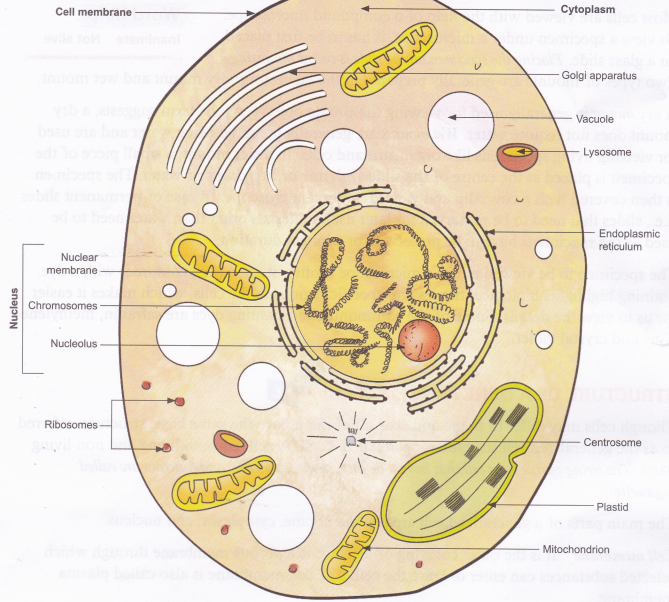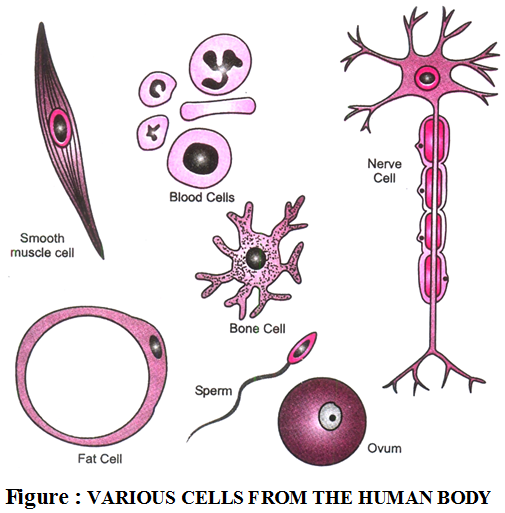Selina Concise Biology Class 9 ICSE Solutions Cell: The Unit Of Life
APlusTopper.com provides step by step solutions for Selina Concise ICSE Solutions for Class 9 Biology Chapter 2 Cell: The Unit Of Life. You can download the Selina Concise Biology ICSE Solutions for Class 9 with Free PDF download option. Selina Publishers Concise Biology for Class 9 ICSE Solutions all questions are solved and explained by expert teachers as per ICSE board guidelines.
Download Formulae Handbook For ICSE Class 9 and 10
ICSE SolutionsSelina ICSE Solutions
Selina ICSE Solutions for Class 9 Biology Chapter 2 Cell: The Unit Of Life
Exercise 1
Solution A.
(a) Ribosomes → Synthesis of proteins
(b) a single cell
(d) cell membrane
(a) absence of centrosome
(c) Cellulose
(a) Mitochondria
Solution B.1.
(a) Mitochondria
(b) Ribosomes
(c) Chromosomes
(d) Centrosome
(e) Lysosomes
(f) Cell membrane
Solution B.2.
(a) F (False). Animal cells do not contain a cell wall.
(b) F (False). A cell wall is made up of cellulose.
(c) T (True)
(d) T (True)
(e) F (False). In eukaryotes, cytoplasm is the part of the cell which surrounds the nucleus.
(f) T (True)
(g) T (True)
Solution B.3.
23 pairs of chromosomes are found in human cells.
Solution B.4.
DNA (Deoxyribonucleic acid)
Solution B.5.
| Column A | Column B |
| (a) Vacuoles | (iii) Covered by tonoplast |
| (b) Nucleolus | (v) Forms RNA |
| (c) Lysosomes | (i) Intracellular digestion |
| (d) Anthocyanin | (iv) Dissolved in the cytoplasm |
| (e) Cristae | (ii) Respiratory enzymes |
Solution B.6.
(a) Lysosome
(b) Centriole
(c) Plasma membrane
(d) Insects
(e) Genes
(f) Leucoplast
Solution C.1.
Protoplasm is the living matter of the cell. Protoplasm cannot be analysed chemically because the chemical composition of protoplasm is very complex. It varies slightly from one cell to another, although the common elements included in the composition of protoplasm such as carbon, hydrogen, oxygen, nitrogen, sulphur, iron and phosphorus are still the same in all the cells.
Solution C.2.
Organs of an organism are the parts of the body which have a definite shape and structure and perform specific functions. Cell organelles are also parts of the cell which have a definite shape and structure and perform specific functions. Organelles have the same status in a cell as the organs have in the entire body of an animal or a plant performing specific functions.
Solution C.3.
The cells of an elephant would be of the same size as the cells of a rat. The size of cells does not vary within the organisms, however, the number of cells varies from one organism to another. A larger animal like an elephant will have more number of cells as compared to a smaller animal like a rat. However, the size of the cell will be the same.
Solution C.4.
(a) Protoplasm and cytoplasm
| Protoplasm | Cytoplasm |
| (i) It is the living matter, the total substance of a living cell, i.e. the cytoplasm and the nucleus. | (ii) It is a mixture of water and soluble organic and inorganic compounds, in which various cell organelles are embedded. |
(b) Nucleolus and nucleus
| Nucleolus | Nucleus |
| (i) It is a round-shaped nucleoli present inside the nucleus. | (ii) It is a dense spherical structure present in the cell that contains a network of thread-like structures called chromatin fibres. |
(c) Centrosome and chromosome
| Centrosome | Chromosome |
| (i) It is a clear area of cytoplasm close to the nucleus, from which spindle fibres develop during cell division. (ii) Centrosome is found only in an animal cell. | (i) Chromosomes carry hereditary information or genes which transmit genetic characters from parents to offspring. (ii) Chromosomes are found in the nucleus of both, animal and plant cells. |
(d) Cell wall and cell membrane
| Cell wall | Cell membrane |
| (i) It is a non-living rigid layer. | (i) It is a living, thin, flexible membrane. |
| (ii) It is made of cellulose. | (ii) It is made of lipoproteins. |
| (iii) It is freely permeable. | (iii) It is semi-permeable. |
(e) Plant cell and animal cell
| Plant cell | Animal cell |
| (i) Cell wall is present. | (i) Cell wall is absent. |
| (ii) Centrosome is absent. | (ii) Centrosome is present. |
| (iii) Vacuoles are large and prominent. | (iii) Vacuoles are small and temporary. |
| (iv) Plastids are present. | (iv) Plastids are absent. |
(f) Prokaryotes and eukaryotes
| Prokaryotes | Eukaryotes |
| (i) Organisms with cells containing a primitive, undefined nucleus are called prokaryotes. | (i) Organisms with cells containing a well-defined nucleus with a nuclear membrane are called eukaryotes. |
| (ii) They contain small ribosomes. | (ii) They contain larger ribosomes. |
| (iii) They lack other cell organelles. | (iii) They contain other cell organelles. |
| (iv) Examples: Bacteria, blue-green algae | (iv) Examples: Euglena, Human beings |
Solution C.5.
Features found only in plant cells:
- Presence of cell wall
- Presence of large vacuoles. The liquid contained in vacuoles is called cell sap
- Presence of plastids
Features found only in animal cells:
- Presence of centrosome
Solution C.6.
Cells generally remain small in size because:
- To enable different regions of the cell to communicate with each other rapidly for the cell to function effectively
- To have a large surface area is to volume ratio for greater diffusion of substances, in and out of the cell
Solution D.1.
Postulates of cell theory:
- Cell is the smallest unit of structure of all living things.
- Cell is the unit of function of all living things.
- All cells arise from pre-existing cells.
Cell theory was propounded by Theodor Schwann and Matthias Schleiden in the year 1839 and was modified by Rudolf Virchow in 1858.
Solution D.2.
| Living cell | Brick in a wall |
| 1. Non-rigid living structure | 1. Rigid non-living structure |
| 2. Mainly composed of cellulose | 2. Mainly composed of soil |
| 3. Freely permeable | 3. Impermeable |
Solution D.3.
| Cells | Plastid | Pigment |
| (a) petals of sunflower | Chromoplasts | Xanthophyll |
| (b) ripe tomato | Chromoplasts | Carotene |
| (c) skin of green mango | Chloroplasts | Chlorophyll |
| (d) cells of potato | Leucoplasts | No pigment |
Solution D.4.
(a) Plasma membrane:
- Separates contents of the cell from its surroundings
- Regulates the entry of certain solutes and ions
- Maintains the shape of animal cell
(b) Ribosome:
- Protein synthesis
(c) Lysosomes:
- Intracellular digestion
- Destroy foreign substances
- When the cell is old or injured, lysosomes rapidly destroy cell organelles and hence, are called suicide bags.
(d) Mitochondria:
- Synthesis of respiratory enzymes
- Release of energy from pyruvic acid produced in cytoplasm in the form of ATP
(e) Golgi apparatus:
- Synthesis and secretion of enzymes, hormones, etc.
- Formation of acrosome of sperm
(f) Cytoplasm:
- Different organelles contained in it perform different functions.
- All metabolic activities occur in it.
(g) Asters of centrosome:
- Initiates and regulates cell division
- Forms spindle fibres
(h) Chromosomes:
- Carry genetic characters from parents to offspring
(i) Glycogen granule:
- Serves as food for the cell
(j) Vacuoles:
- Gives turgidity to the cells
- Storage of water and other substances, food, pigments and waste products
Solution D.5.
Common features found in both plant and animal cells:
- Presence of cell membrane
- Presence of liquid matrix called cytoplasm in the cell
- Presence of mitochondria which produces energy
- Presence of ribosomes that synthesize proteins
- Presence of Golgi body
- Presence of a prominent nucleus
Solution E.1.
(a) Fig. B is a plant cell. It has a cell wall and a large vacuole which pushes the nucleus towards the periphery.
(b) Cell membrane, ribosomes, nucleus, endoplasmic reticulum, lysosomes, Golgi body and mitochondria are common to both the types.
(c) Plastids and cell wall are found only in plant cell. Centrosome is found only in animal cell.
More Resources for Selina Concise Class 9 ICSE Solutions


